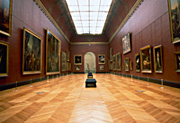|
 |
Louvre-DNP Museum Lab Customer Center
Tel: +81 (0) 35435 0880, Monday to Friday, 9 a.m. to 6 p.m. Closed on Saturday,Sundays and public holidays. |
|
 |
|
 |
 |
 |


© 1995 Musée du Louvre / Pierre Ballif |
 |
The Department of Paintings reflects the encyclopedic scope of the Louvre, encompassing every European school from the 13th century to 1848. The collection is overseen by twelve curators, who are among the most renowned experts in their field. |
 |
 |
 |
 |
History of the Collection |
 |
 |
The Louvre's collection of paintings dates back to the reign of Francis I of France, who sought to create a gallery of art in his château at Fontainebleau rivaling those of the great Italian palaces. He acquired masterpieces by leading Italian masters (Michelangelo, Raphael) and invited Italian artists to his court (Leonardo da Vinci, Rosso, and Primaticcio). The French royal collections grew steadily as successive sovereigns made acquisitions reflecting the tastes and fashions of their time—Louis XIV's purchase of the collections of the banker Jabach is a prime example. Louis XIV also expanded the collection of Italian paintings. The first Spanish paintings (by Murillo) and a series of French works (Le Sueur) were acquired during the reign of Louis XVI. Works from the Northern schools appeared first during the 17th century and, above all, the 18th.
In 1793, these works formed the core collection of the Muséum Central des Arts, opened within the Louvre after the Revolution. Throughout the 19th century, confiscated French aristocratic collections and the spoils of the Napoleonic conquests brought important new acquisitions. Other works were purchased from individuals (Marquis of Campana) or were acquired through the Paris Salons and donations (the collection of Dr. La Caze in 1869).
With the opening of the Musée d'Orsay in 1986, the collection was split up, with works painted after the 1848 Revolution (including pictures by Courbet and the Impressionists) transferred from the Louvre to the newly renovated Gare d'Orsay. |
Donors and art patrons have played a key role in the museum's history. Of these, the association known as the Société des Ams du Louvre (the Friends of the Louvre) is the most important. Created one hundred years ago, it has purchased a considerable number of works from all periods and schools, many of exceptional artistic value.
The museum's individual donors include a number of distinguished names that have become closely linked with collection's history and with the rediscovery of certain painters or periods. These include La Caze, Moreau-Nelaton, Rothschild, and more recently, Lemme, Kauffmann, and Schlageter. The La Caze collection, for example, brought the first significant influx of 18th-century works to the museum, while the Lemme donation recently filled important gaps in the collection of 18th-century Italian paintings. Among the most significant donated collections, three have been preserved intact, in keeping with the wishes of their former owners: Carlos de Beistegui's remarkable collection of portraits, donated in 1942; Dutch works from the collection of the comte de l'Epine, donated by his daughter, Princess Louis de Croy in 1930; and the more heterogeneous collection of Impressionist and older paintings bequeathed in 1961 by Victor Lyon. These remarkable donations are exhibited on the second floor of the Cour Carrée.
In recent years, companies and major financial groups have become important new donors and supporters. Private donations have often provided little-known or rare works, reinforcing the distinctive character of the department's collection. |
 |
 |
 |
 |
How the Works Are Displayed |
 |
 |
The Louvre's collection of Italian and Spanish paintings occupies the entire first floor of the Denon wing; French and Northern schools, arranged in chronological order, take up the entire second floor of the Cour Carrée and the Richelieu wing.
This is the latest arrangement in the three-hundred-year history of painting galleries within the Louvre palace. Initially, paintings were exhibited in the Grande Galerie and the Salon Carré. Later, the galleries were extended to the rooms around the Cour Carrée—the very apartments which were used as artist's lodgings in the 18th century. Indeed, some works are now exhibited just a few meters from where they were originally painted. Vouet, Le Brun, Fragonard, and David all lived at the Louvre for a time.
A series of paintings by artists such as Hubert Robert depict views of the galleries in their early state, and show how the paintings were hung. The dense, opulent displays of the 18th and 19th centuries gave way to a more rational and less congested layout in the 20th century, reflecting developments in art history and new research on painters and schools.
The diverse decorative schemes seen throughout the palace chart three hundred years in the history of French taste. These "works in situ" form an exceptional collection. They include the Romanelli ceilings in Anne of Austria's summer apartments, and decorations specially painted for the museum in the 19th and 20th centuries (the Duchatel room, and Braque's Birds in the ceiling of the Salle Henri II). |
|

